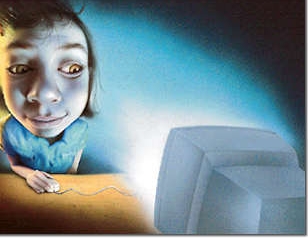Cerebral Fodder
![]()
March 2005
The Digital Ache

a Cyber Trilogy
first published in NEW Quest, No.147 (Jan-Mar) 2002
a quarterly journal of participatory inquiry
devoted to politics, culture, literature & society
Cyber 3
Cyber-NET-ics
The 'Closeted' Nomad
Cultural & Social Implications of Cyberspace
by Jayant Deshpande

Nomads have traditionally resisted a sedentary life. In the cyberage we now have cyber-nomads, people who live a sedentary life but roam the world electronically via e-mail, fax, the Internet. They surf on the sea of information, and create the illusion that they're going places—in a sense they are.
Traditional nomads are wanderers who seldom communicate with the outside world. Cyber-nomads are physically sedentary beings who communicate constantly with the outside world. Traditional nomads maintain their distinct identity by virtue of their isolation.
|
With millions of cyber-nomads populating the airwaves, language, the last frontier of identity, may soon be conquered—we'll all be speaking the same language, becoming in the process humans without distinct identities. On the other hand the NET may prove to be a powerful way of retaining and further enriching existing identities since fewer and fewer people will need to migrate, or even travel. Less mixing in person would mean less exchange in any real sense. A common language would be mastered, but most other things would remain provincial. But herein lies the paradox: language, and now multimedia, allows people to adopt wide-ranging lifestyles and cultural practices at will as satellite TV has already shown us. As an interactive medium, the Net encourages people to participate more actively in cultural exchange, albeit while chained to a keyboard in the privacy and security of one's home. The question to ask is not what our place is in the cyber or e-world, or how we find our way through the cybermaze, but what place this new world assumes in our own personal space. What inroads will it make? The phone overcame the distancing, though highly personal, nature of the posted letter. Then we devised ways to avoid picking up the phone. Now we've got email to do that job: personal but ephemeral, as phantoms are bound to be, and direct to the extent we make it so. It's fast, like the phone, but avoids contact—one has the option of not responding, like the letter of old. So is it back to the tried and tested letter if we want serious communication that avoids direct contact? Can we stomach this strange irony? The telephone, already entrenched as an extension of our sense of hearing, has further extended our reach through the Net. The internet has breathed new life into the economy of 'ideas' or 'intellectual property' as opposed to things. We're constantly aware of its buzz. If it were suddenly to stop, the death-like silence would be palpable. We have a physical body and we live in a physical universe, and both are governed by physical laws. But we also have a brain. We inhabit, more than anything else, a symbolic universe, made up of words, gestures, numbers, signs, metaphors, images. So it is little wonder that we can quite comfortably adopt, and adapt to, a cyber-universe which capitalizes on those symbols. The symbols are our world. That is how we perceive ourselves and develop a world-view, without which our existence would become meaningless. Cyberspace deals not with physical bits but phantom bytes. Not atoms, but the binary code of machine language. John A. Wheeler, of quantum and 'black hole' fame, suspects that reality exists not because of physical particles but because of the act of observing the universe. "Information may not be just what we learn about the world," he says. "It may be what makes the world." Through the countless phantoms it generates, cyberspace appears to portend a kind of 'symbolic' consciousness that binds all human beings. Yet a technological togetherness can't be confused with a global awareness that leads to greater understanding and tolerance. The media can easily induce a superficial familiarity: images without context, indignation without remedy. While images become international, people's lives remain parochial. When we see images of terrorist attacks in Kashmir or the Middle East, or of natural disasters, the pain is alien to us. Experienced only vicariously. Our senses have been numbed, and our knowledge is half-baked. TV images are two-dimensional and disjointed, selected for their newsworthiness. The narrative is lost—in cyberspace.
related links: |